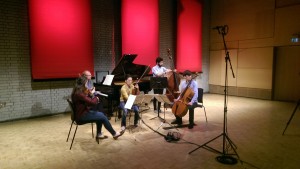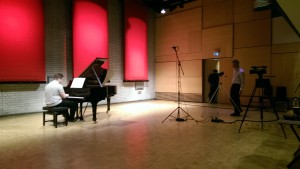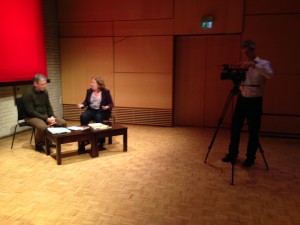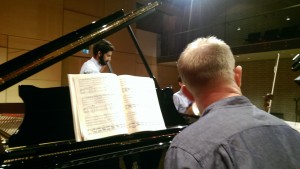Recently Naomi Barker and Catherine Tackley spent the day at the Royal Northern College of Music (RNCM) in Manchester filming content for the Department’s Futurelearn Massive Open Online Course (MOOC) From notation to performance: Understanding musical scores. In the first of a series of blogs ‘behind the scenes at the OU Music Department’, Catherine reflects on the experience.
Many of us in the Department make our own audiovisual material for use in teaching and also as part of our research. However, film has a rather different role to play in the MOOC, where teaching is much more concentrated (our MOOC has 4 weeks with roughly 3 hours of learning time in each) and no prior knowledge of music is required, so we have to ensure that the content is understandable by as many people as possible. We also know from statistics about participation on MOOCs that students tend to ‘switch off’ after a few minutes of a video, so these also need to be kept succinct.
The films we were making serve two main purposes; firstly, to provide performances of the key works covered in the MOOC which clearly show the features that we discuss in the text, and secondly, to allow students to hear the musicians speak about the way that they use notation in preparation, rehearsal and performance. We had briefed the musicians in advance about the type of things we wanted them to cover, and the level of detail that would be appropriate.
We began with the largest group, a string quintet – first recording performances that everyone wa s happy with, showing the whole group and close-ups of particular players in particular sections of the music that will then be edited to make a seamless whole.
s happy with, showing the whole group and close-ups of particular players in particular sections of the music that will then be edited to make a seamless whole.
Then it was time for the interviews, and we encouraged the players to demonstrate as they responded to questions from Naomi about how they used scores to co-ordinate the way they worked as a group in rehearsals, how their parts related to the whole, and how they achieved balance between different musical ideas happening at the same time.
Next we worked with pianist Alexander Panfilov,  playing some Mozart variations. Again, impeccable and brilliant performances were swiftly documented, and Alexander talked with Naomi about how he interprets the score and uses it to prepare for a performance. Alexander will be taking part in the prestigious Leeds International Piano Competition shortly after the MOOC is presented.
playing some Mozart variations. Again, impeccable and brilliant performances were swiftly documented, and Alexander talked with Naomi about how he interprets the score and uses it to prepare for a performance. Alexander will be taking part in the prestigious Leeds International Piano Competition shortly after the MOOC is presented.
After lunch, we moved on to Catherine’s interviews with conductor Mark Heron about how a conductor uses scores in preparation, rehearsals and performances.  Focussing on the symphonic repertoire, Mark gave some fascinating insights into the work of a conductor, usually the only musician who has a full score in front of him or her during a performance, a topic that is often shrouded in mystery.
Focussing on the symphonic repertoire, Mark gave some fascinating insights into the work of a conductor, usually the only musician who has a full score in front of him or her during a performance, a topic that is often shrouded in mystery.
Finally, Naomi and I recorded our introductory video which will welcome our first cohort to the MOOC when the course begins on 3 August. Although we research and perform completely different types of music (early music and jazz), we are both interested what scores do and don’t include and how musicians deal with this. Working on this MOOC has reinforced the importance of teaching students how to understand musical texts. But beyond this, scores need to be interpreted and turned into sound – it’s this process that we explore.
With thanks to all the musicians and the RNCM, particularly Jeremy Young, Head of Chamber Music and Principal Linda Merrick. We are grateful to Clearfocus productions for their assistance.


Fantastic stuff, Catherine! My wife has already signed up for the MOOC and is looking forwards to it immensely.